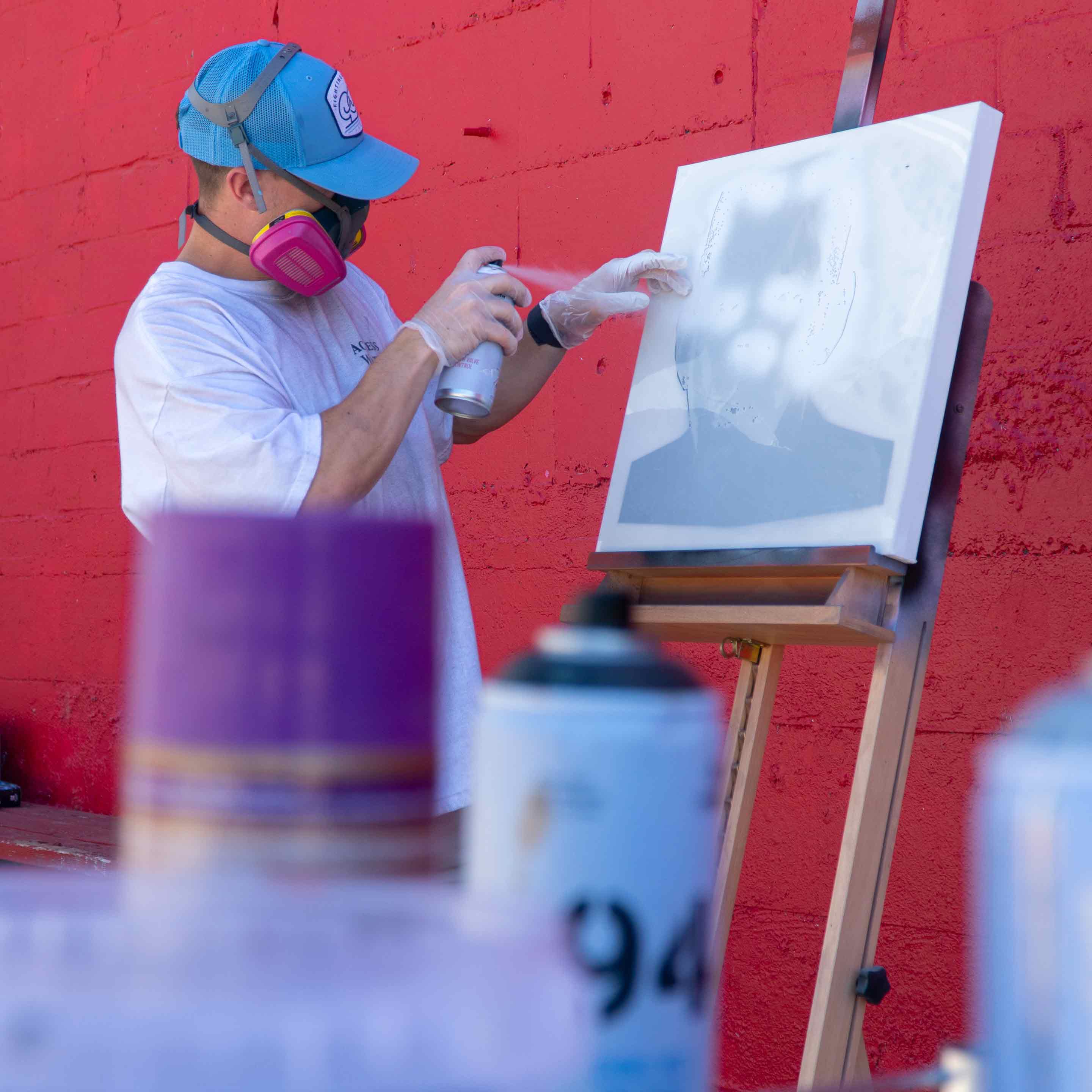Keeping Your Stencils Clean for Sharper Results
To maximize the life of a mylar stencil, it's important to use the proper tools and techniques for cleaning and storage. With proper care, a stencil can be used many times.
Cleaning stencils can be a messy process. Wear clothes and use tools that can get covered in paint.
What you need
- Acetone: This is our favorite solvent for removing common types of paint (latex-based, acrylics, and spray paint) from mylar stencils. Nail polish remover can also be used if it contains acetone as an ingredient.
- Metal tray, towel, or plastic drop cloth: Depends on your stencil's size. If it's small enough, you can use an old cookie sheet to submerge a stencil in acetone. Otherwise, you'll need a larger area covered in a towel or drop cloth.
- Scrub brush
- Rag
- Dish soap
- Butyl rubber gloves: Not nitrile or latex gloves. Both will dissolve when working in contact with acetone.
- Q-tips: These are optional if you have smaller, more detailed areas of your stencil where paint has accumulated.
- Goo Gone: For removing any adhesives that are stuck on the stencil.
- Ventilated mask: Highly recommended when working with paint and acetone.
We recommend acetone for removing paint from a stencil's surface. It's a tricky and potentially harmful chemical, so we wanted to provide additional safety guidelines for working with acetone.
Working with acetone
- Work outside or in a well-ventilated area.
- (Optional) Wear butyl rubber gloves. Do not use latex or nitrile gloves as they will dissolve when they come in contact with acetone. Acetone is very drying on the skin but not harmful in small quantities.
- Acetone evaporates quickly. Don’t leave the acetone container open.
- Wear a ventilated mask. Inhaling acetone fumes can cause dizziness, headaches, and irritate your nose and lungs.
- Acetone can cause dryness in your skin. If you have sensitive skin, avoid making direct contact if possible.
How often should stencils be cleaned?
Stencils are created with a vast array of sizes, designs, and levels of detail. They're also used with all kinds of different paints and on different surfaces in different environments. Therefore, the frequency in which a stencil should be cleaned also varies greatly.
Paint tends to build in the little crevices and corners of a stencil design. When this happens, the stenciled result may appear less precise. If it seems that a stencil isn't providing the best outcome for a project, it may be time to begin the paint removal process.
How to remove dried paint from mylar stencils
1. Remove dirt and debris from stencil surface
Use water, a bit of dish soap, and a rag to remove any dust or dirt from the stencil. Use Goo Gone to remove any sticky adhesives that may be remaining. Goo Gone won't damage the stencil.

2. Use acetone to remove paint
For stencils small enough to fit into a shallow tray, pour a very thin layer of acetone into the tray, enough to submerge a single stencil. Wearing butyl rubber gloves, place the stencil, paint side down, into the acetone bath. Let the stencil soak for 15 minutes if spray paint was used, and 30 minutes if acrylic paint or latex paint was used on the stencil. Some of the acetone will evaporate during this time. After a while, add a bit more if it looks like the paint on the stencil is no longer covered.

When removed from the acetone bath, the paint should be significantly loosened from the stencil's surface. Use a scrub brush or a rag to clear away the remaining paint.

For larger stencils, place on a towel or drop cloth, paint side up. (Whatever the stencil is placed on will likely end up with paint on it.) Wearing butyl rubber gloves, and using your other hand to secure the stencil so it doesn't move, dab a small amount of acetone onto the rag or scrub brush. In the larger, less detailed areas of the stencil, scrub back and forth or in circles until the paint is cleaned away.

Note: The plastic may become stained if spray paint is left on it for more than a few months. This does not affect the stencil's performance.
3. Touch up detailed edges and corners
Using a Q-tip dabbed with acetone, lightly rub away excess paint. Go softly and slowly in detailed areas to avoid bending, breaking, or damaging the stencil. Paint may have stained the stencil's edges, but will not future stencil use.

How to store and organize stencils
- Keep stencils as flat as possible.
- Store stencils out of direct sunlight, ideally indoors at room temperature.
- Larger stencils can be stored vertically, placed back into their original shipping package or sandwiched between flat pieces of cardboard.

How we tested and researched
We compiled other stencil cleaning methods and spent days testing to determine which worked best. Many articles suggest using mixtures of vinegar and water, or dish soap and a scrub brush. Trying every combination of ingredients and instructions we could find, we tested the methods on old, crusty stencils that have been laying around our warehouse in various forms - bent, flat, small, large, left outdoors, covered in different types of paint.
Vinegar, water, and dish soap are not abrasive enough (even with a scrub brush) to easily remove latex paint and spray paint. After trying other available methods, we recommend acetone as the best stencil cleaning solvent.



3 comments
can you leave the stencil in warm soapy water and then use a brush to scrub the stencil clean/
DEBORAH or Debbie Hren
Well explained and very informative. The verification of the exact info I was wondering about for purchasing some reusable 6" inch plastic letter stencils to high-visibility prominently identify company name on various gear boxes, carts, machinery, etc. This helped a ton.
One detail worth mention is that this article stresses the importance of wearing butyl rubber gloves anytime working with acetone to remove paint from stencils, yet ironically more than one accompanying demonstration example picture (approx 4 or 5) inexplicably shows completely ungloved bare skin hands using procedure(s) as described. That should be corrected as soon as possible, by replacing the current example pictures with models whose hands are wearing what at least appear to be butyl gloves.Anthony
Hmm it seems that pure acetone dissolve DuraLar. Is the chemical composition such that DuraLar would dissolve in pure acetone but Mylar will not? If so, any suggestions on cleaning DuraLar stencils?
Dan
Leave a comment
This site is protected by hCaptcha and the hCaptcha Privacy Policy and Terms of Service apply.